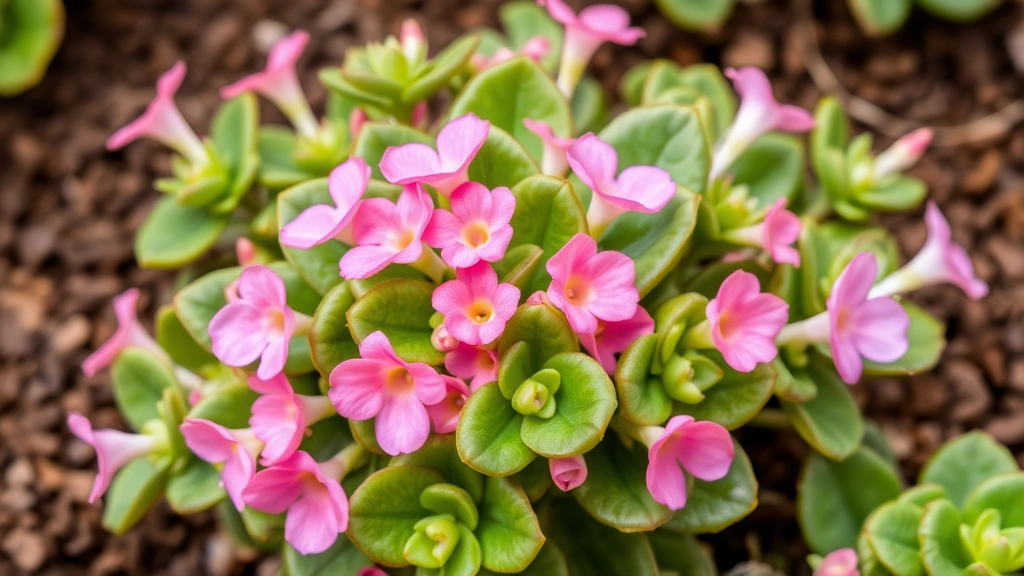Kalanchoe Succulent Pink: A Showstopper for Your Garden
Searching for the perfect addition to your succulent collection? Kalanchoe Succulent Pink, also known as Kalanchoe ‘Pink Butterflies’, is a showstopper with its vibrant pink plantlets that resemble tiny butterflies. This unique succulent not only adds a splash of colour to your garden but also sparks joy with its whimsical appearance. Let’s dive into what makes this plant special and how you can grow it successfully at home.
Growing Conditions for Kalanchoe ‘Pink Butterflies’
To ensure your Kalanchoe ‘Pink Butterflies’ thrives, it’s essential to provide the right growing conditions. This succulent loves bright, indirect sunlight, which helps maintain its vivid pink hues. Watering should be minimal—only when the soil is completely dry—to prevent root rot. A well-draining soil mix is crucial for healthy growth.
Propagation Tips
Interested in propagating? Learn how to turn those charming plantlets into full-grown plants with ease. Keep reading for detailed care tips and tricks to keep your Kalanchoe Succulent Pink flourishing year-round.
What Makes Kalanchoe âPink Butterflies’ Unique?
When considering unique houseplants, many ask, “What sets Kalanchoe âPink Butterflies’ apart from other succulents?”
This stunning succulent captivates with its vibrant pink, butterfly-shaped leaves, making it a favourite among plant enthusiasts.
Key Features:
– **Distinctive Appearance:** The leaves emerge in a rosette formation, adorned with a soft pink hue that deepens with exposure to sunlight.
– **Compact Growth Habit:** Ideal for small spaces, this plant remains relatively small, making it perfect for windowsills or desks.
– **Easy Care:** Kalanchoe âPink Butterflies’ is known for its resilience, thriving in less-than-perfect conditions, which makes it an excellent choice for both novice and experienced gardeners.
– **Flowering Potential:** With the right care, it can produce small, tubular flowers that add to its charm, typically blooming in late winter to early spring.
– **Air Purifying Qualities:** Like many succulents, it helps improve indoor air quality, making it not just a pretty face but also a beneficial addition to your home.
For more detailed care tips, you can refer to this [complete care guide for Kalanchoe Beharensis](https://planthq.org/complete-care-guide-for-kalanchoe-beharensis-felt-plant/) or explore the [varieties and care tips of Kalanchoe Tomentosa](https://planthq.org/types-of-kalanchoe-tomentosa-varieties-and-care-tips/).
Ideal Growing Conditions for Kalanchoe Succulents
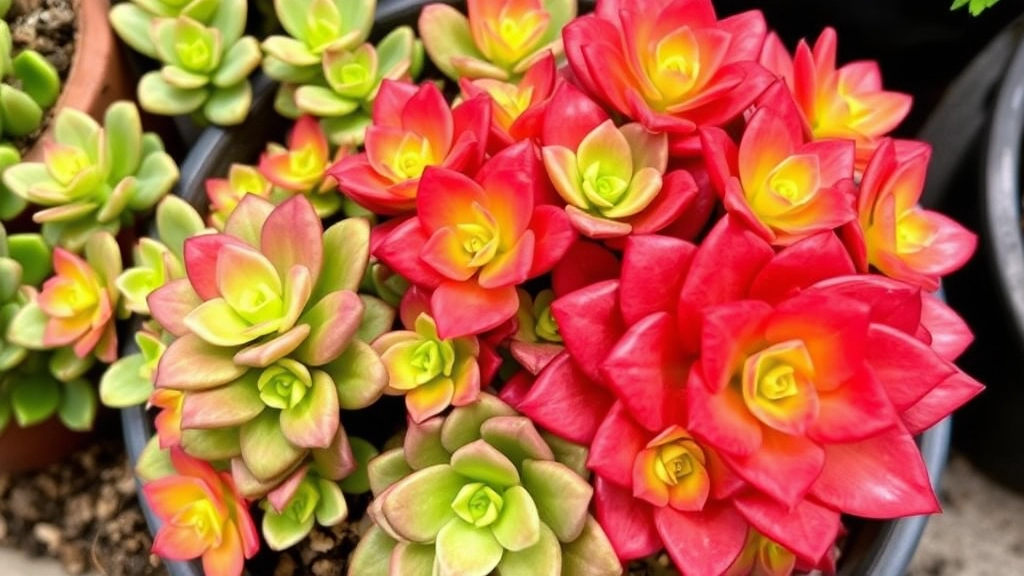
So, you’ve got your eye on Kalanchoe ‘Pink Butterflies’ and you’re wondering what it needs to thrive.
Let’s dive into the ideal growing conditions for these beauties.
Temperature
- Warmth is Key: Kalanchoe loves warmth. Aim for temperatures between 18°C to 24°C (65°F to 75°F).
- Avoid Frost: These plants are not fans of cold. Keep them indoors or protected if you live in a chilly area.
Humidity
- Low Humidity: Kalanchoe prefers a dry environment. High humidity can lead to issues like rot.
- Airflow: Good airflow is essential. A little breeze can do wonders for keeping them healthy.
Location
- Bright Spots: Find a bright spot in your home. Near a window is perfect, just be cautious of harsh afternoon sun.
- Avoid Direct Sunlight: While they love light, too much direct sunlight can scorch those lovely leaves.
Fertilisation
- Feed Sparingly: Use a cactus or succulent fertiliser during the growing season (spring and summer).
- Frequency: Once a month is usually enough. Over-fertilising can harm your plant.
Container and Drainage
- Well-Draining Pots: Choose pots with drainage holes. This prevents water from sitting at the bottom.
- Size Matters: A pot that’s too big can lead to overwatering. Stick to a snug fit.
Light Requirements for Vibrant Pink Plantlets
When it comes to nurturing Kalanchoe âPink Butterflies’, understanding its light requirements is crucial for achieving those stunning, vibrant pink plantlets. You might be wondering: how much light does this succulent really need to thrive?
Watering Schedule for Healthy Growth
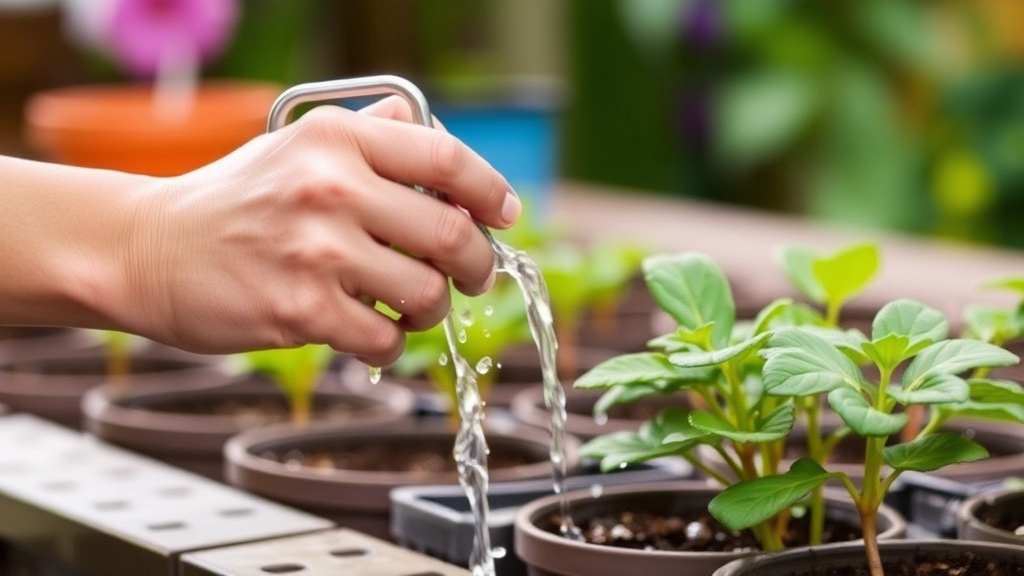
When caring for Kalanchoe ‘Pink Butterflies’, one of the most pressing concerns is how often to water. Overwatering is a common mistake that can lead to root rot, while underwatering can stunt growth. So, how do you strike the right balance?
Understanding Watering Needs
Kalanchoe succulents thrive in a semi-arid environment, so they require a specific watering schedule to flourish. Here are some key points to keep in mind:
- Frequency: Water every 2-3 weeks during the growing season (spring and summer). In winter, reduce this to once a month.
- Soil Check: Always check the top inch of the soil. If it feels dry, it’s time to water. If it’s still moist, wait a few more days.
- Watering Method: Use the soak and dry method. Water deeply until it drains from the bottom, then allow the soil to dry out completely before the next watering.
- Time of Day: Water in the morning to prevent excess evaporation and to allow the plant to absorb moisture throughout the day.
Signs of Proper Watering
To ensure your Kalanchoe is receiving the right amount of water, look for these signs:
- Healthy Leaves: Plump, firm leaves indicate adequate hydration.
- Growth: New growth during the active season is a good sign.
- Flowering: If your plant blooms, it’s a clear indicator that it’s happy and healthy.
Common Mistakes to Avoid
- Watering Too Often: This is the leading cause of issues. Stick to the schedule and adjust based on environmental conditions.
- Ignoring Soil Type: Ensure that your soil drains well; a compacted mix can hold too much moisture.
When it comes to nurturing Kalanchoe âPink Butterflies’, the right soil mix is essential for optimal growth. You might be wondering, what kind of soil does this succulent truly thrive in?
### Ideal Soil Characteristics
Kalanchoe succulents prefer a well-draining soil that mimics their natural habitat. Here are the key components to consider:
– **Drainage**: Ensure the soil allows excess water to escape, preventing root rot.
– **Aeration**: A mix that promotes airflow to the roots is crucial.
– **Nutrient Content**: While Kalanchoe doesn’t require overly rich soil, a balanced nutrient profile supports healthy growth.
### Recommended Soil Mixes
Here are some popular soil mixes that work wonders for Kalanchoe âPink Butterflies’:
– **Commercial Cactus Mix**: These are specifically formulated for succulents and cacti, providing excellent drainage.
– **DIY Mix**: Combine:
– 50% potting soil
– 25% perlite or pumice
– 25% coarse sand
This blend offers the perfect balance of nutrients, drainage, and aeration.
### Additional Tips for Soil Preparation
– **Check pH Levels**: Kalanchoe prefers a slightly acidic to neutral pH (around 6.0 to 7.0).
– **Sterilize Soil**: If using garden soil, consider sterilizing it to eliminate pests and diseases.
For more detailed tips on soil preparation and care, you can explore the [best soil for Kalanchoe Blossfeldiana care tips](https://planthq.org/best-soil-for-kalanchoe-blossfeldiana-care-tips/). Additionally, if you are interested in the specific care needs of different Kalanchoe varieties, check out this [complete care guide for Kalanchoe Blossfeldiana](https://planthq.org/complete-care-guide-for-kalanchoe-blossfeldiana-succulent/).
Propagation Techniques: From Plantlets to Full Plants
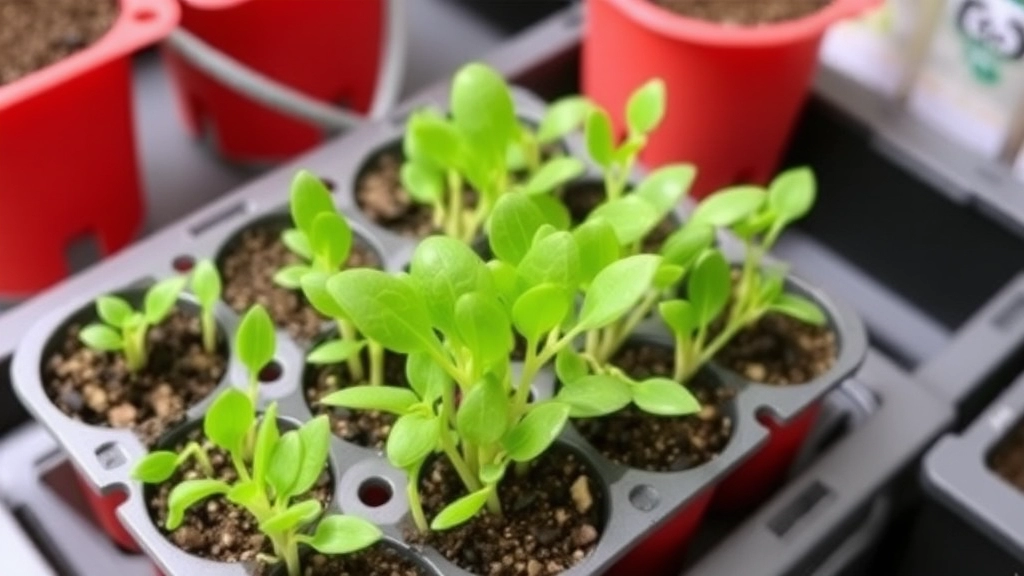
So, you’ve got your Kalanchoe ‘Pink Butterflies’ thriving, and now you’re probably wondering how to multiply that beauty, right? Propagating this succulent is not just rewarding; it’s pretty simple too!
Here’s how to get started:
- Leaf Cuttings:
- Snip a healthy leaf from the parent plant.
- Let it dry for a day or two to form a callus on the cut end.
- Place it on well-draining soil and mist lightly.
- In a few weeks, you’ll see tiny plantlets sprouting!
- Offsets:
- Look for small plantlets at the base of the main plant.
- Gently twist or cut them off.
- Plant them in their own pots with the right soil mix.
- Voila! You’ve got new plants ready to grow.
- Seeds:
- If you’re feeling adventurous, you can also try growing from seeds.
- Scatter seeds on a moist soil surface and cover lightly.
- Keep them in a warm, bright spot, and soon you’ll see sprouts.
Remember, patience is key here.
Common Pests and How to Control Them
As we delve deeper into caring for your Kalanchoe âPink Butterflies’, it’s crucial to be aware of the pests that can threaten its vibrant growth.
What Pests to Look Out For
- Aphids: Tiny insects that suck sap from your plant, leading to wilting.
- Mealybugs: White, cotton-like pests that hide in leaf joints.
- Spider Mites: These arachnids create fine webs and can cause leaf discoloration.
- Scale Insects: Small, flat pests that attach themselves to stems and leaves.
Control Measures
- Regular Inspection:
- Check your plants weekly for any signs of pests.
- Look under leaves and in leaf joints where pests often hide.
- Natural Remedies:
- Neem Oil: Spray a diluted solution on affected areas.
- Insecticidal Soap: Effective against soft-bodied pests like aphids and mealybugs.
- Physical Removal:
- For minor infestations, use a cotton swab dipped in alcohol to wipe off mealybugs.
- A strong jet of water can dislodge spider mites.
- Maintain Healthy Conditions:
- Ensure your Kalanchoe is not stressed, as healthy plants are less susceptible to pests.
- Avoid overcrowding, which can create a humid environment conducive to pest infestations.
Preventative Measures
- Proper Care: Healthy plants are less likely to attract pests. For optimal growth, refer to this Optimal Care for Kalanchoe Blossfeldiana guide.
- Quarantine New Plants: Keep new additions separate for a few weeks to monitor for pests.
- Keep the Area Clean: Remove dead leaves and debris around your plants to reduce hiding spots for pests. For more detailed care tips, check out the Ultimate Guide to Caring for Kalanchoe Succulents.
Dealing with Overwatering and Root Rot
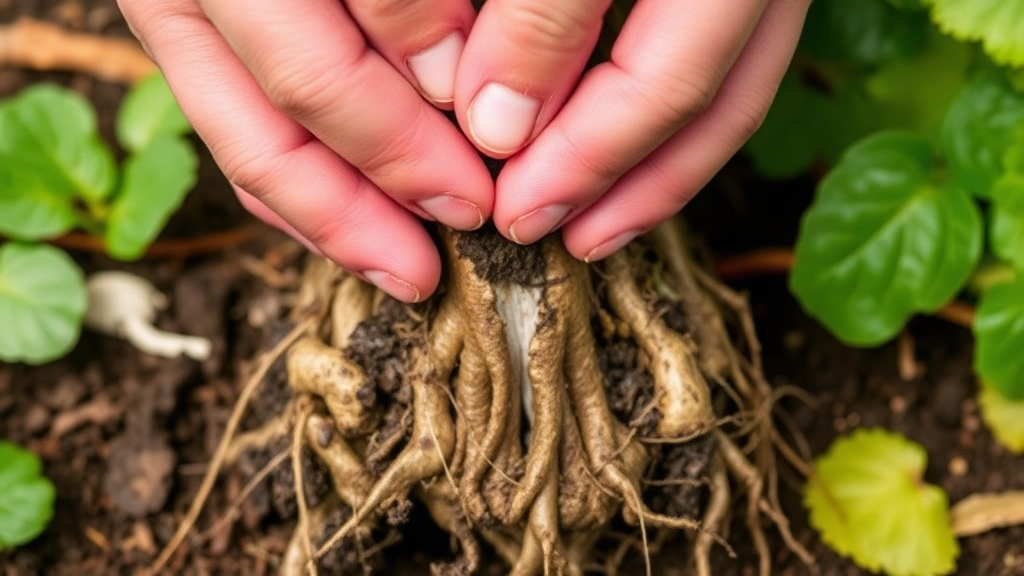
Have you ever noticed your Kalanchoe ‘Pink Butterflies’ looking a bit sad?
Overwatering can be a sneaky culprit, leading to root rot that can kill your beautiful plant.
Let’s dive into how to spot the signs and what you can do to rescue your succulent.
Signs of Overwatering
- Yellowing Leaves: If the leaves start turning yellow, it’s a red flag.
- Soft, Mushy Stems: Healthy stems are firm; mushy ones indicate trouble.
- Wilting: Surprisingly, overwatered plants can also wilt.
If you see any of these signs, it’s time to take action.
Steps to Fix Overwatering
- Stop Watering: First things first, hold off on giving your plant any water.
- Check the Soil: Stick your finger in the soil. If it’s soggy, that’s not good.
- Inspect the Roots: Gently remove the plant from its pot. Look for brown, mushy roots. If you find them, you’ll need to trim them away.
- Repot: Use a well-draining soil mix to repot your Kalanchoe. This will help prevent future issues.
- Adjust Watering Schedule: Make sure you’re not watering too frequently. Kalanchoes prefer to dry out between waterings.
Prevention Tips
- Choose the Right Pot: Ensure your pot has drainage holes.
- Use Well-Draining Soil: A cactus mix works wonders.
- Monitor Watering: Remember, it’s better to underwater than overwater.
IX. Seasonal Care: Adapting to Winter and Summer
As we dive into the seasonal care of Kalanchoe âPink Butterflies’, it’s essential to understand how changing weather conditions can impact its growth.
Understanding Seasonal Changes
Winter Care:
During winter, Kalanchoe âPink Butterflies’ enters a period of dormancy. This means it requires less attention than in the vibrant summer months.
- Light: Position your plant near a south-facing window to maximise sunlight exposure. Shorter days can lead to leggy growth if light is insufficient.
- Watering: Reduce your watering frequency. Check the soil moistureâonly water when the top inch feels dry. Overwatering in winter can lead to root rot.
- Temperature: Keep your plant in a warm spot, ideally between 15°C to 21°C. Avoid cold drafts, as Kalanchoe is sensitive to temperature drops.
Summer Care:
As the temperatures rise, your Kalanchoe will thrive and require a bit more care.
- Light: Ensure it receives bright, indirect sunlight. Too much direct sun can scorch the leaves.
- Watering: Increase the watering frequency, allowing the soil to dry out between waterings. During hot spells, you may need to check moisture levels more often.
- Humidity: Kalanchoe prefers drier air, so avoid placing it in overly humid environments.
General Tips for Seasonal Transition
- Fertilisation: During the active growing season (spring and summer), feed your Kalanchoe with a balanced, diluted fertiliser every few weeks. In winter, hold off on fertilising.
- Monitoring Growth: Keep an eye on your plant’s health. If you notice any changes in colour or leaf drop, adjust your care routine accordingly.
For more detailed information on caring for different varieties of Kalanchoe, you might find our ultimate guide on Kalanchoe care and the optimal care for Kalanchoe Blossfeldiana particularly useful.
Repotting and Container Selection for Optimal Growth
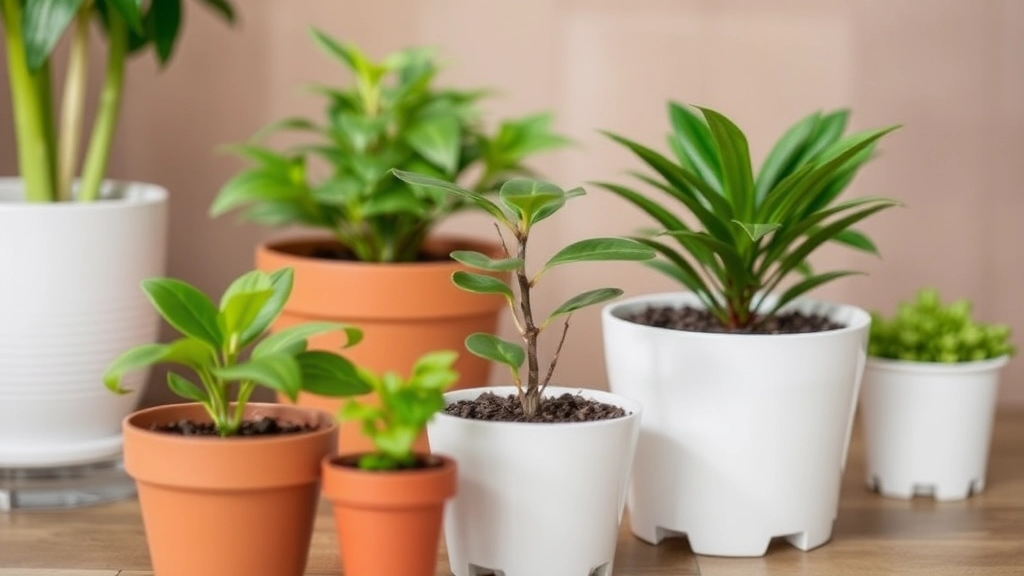
So, you’ve got your Kalanchoe ‘Pink Butterflies’ thriving, but how do you keep it that way? One key aspect is repotting and choosing the right container.
When should you repot?
- Signs it’s Time: If you notice roots growing out of the drainage holes or the plant seems top-heavy, it’s time for a new pot.
- Frequency: Generally, repot every 1-2 years, or when you see those signs.
What size pot should you choose?
- Container Size: Go for a pot that’s one size larger than the current one. Too big, and you risk overwatering; too small, and it’ll stunt growth.
- Material Matters: Terracotta pots are great for succulents because they’re breathable, allowing moisture to escape.
Drainage is Key
- Drainage Holes: Always select a container with drainage holes to prevent root rot.
- Layering: Consider adding a layer of small stones at the bottom for extra drainage.
Choosing the Right Soil
- Soil Type: Use a well-draining soil mix, like cactus or succulent mix, to keep your Kalanchoe happy.
- DIY Mix: You can easily make your own by mixing regular potting soil with perlite or sand.
Timing Your Repotting
- Best Time: Early spring is ideal, just as your plant is waking up from its winter slumber.
- Gentle Handling: When repotting, be gentle with those delicate roots.
Toxicity Considerations for Pets and Humans
When it comes to caring for Kalanchoe âPink Butterflies,’ many plant enthusiasts worry about the safety of their furry friends and family members.
Are Kalanchoe plants safe for pets?
The answer is a bit concerning. Kalanchoe species, including âPink Butterflies,’ contain compounds that can be toxic to cats, dogs, and even humans.
Key Toxicity Points:
- Toxic Compounds: Kalanchoe contains bufadienolides, which can lead to gastrointestinal upset and, in severe cases, heart issues in pets.
- Symptoms to Watch For: If ingested, pets may exhibit symptoms such as vomiting, diarrhoea, and lethargy. In humans, mild irritation can occur, particularly if sap comes into contact with skin or eyes.
- Immediate Action: If you suspect your pet has ingested any part of the plant, it’s crucial to contact your veterinarian or a poison control centre immediately.
Safety Tips:
- Placement: Keep Kalanchoe out of reach of pets and children. Hanging baskets or high shelves are ideal.
- Education: Teach family members about the potential dangers of this plant, especially if they have young children or pets in the house.
By being aware of these toxicity considerations, you can enjoy your Kalanchoe âPink Butterflies’ while keeping your loved ones safe. For comprehensive care tips, check out our ultimate guide on Kalanchoe care. Additionally, learn about the best practices for watering Kalanchoe Tomentosa to ensure your plant thrives.
FAQs on Kalanchoe Succulent ‘Pink Butterflies’
What are the ideal growing conditions for Kalanchoe succulents?
Kalanchoe succulents thrive in warm temperatures (18°C to 24°C or 65°F to 75°F) and low humidity environments. They prefer bright, indirect light and well-draining pots to avoid water accumulation.
How often should I water my Kalanchoe ‘Pink Butterflies’?
Water every 2-3 weeks during the growing season (spring and summer) and reduce to once a month in winter. Always check the top inch of the soil; if it’s dry, it’s time to water.
What are the signs of overwatering in Kalanchoe succulents?
Signs of overwatering include yellowing leaves, soft and mushy stems, and wilting. If you notice these symptoms, it’s crucial to take immediate action to prevent root rot.
How can I propagate Kalanchoe ‘Pink Butterflies’?
You can propagate Kalanchoe through leaf cuttings, offsets, or seeds. Each method involves specific steps, such as allowing cuttings to callus before planting and ensuring proper soil and moisture conditions.
When should I repot my Kalanchoe ‘Pink Butterflies’?
Repot your Kalanchoe every 1-2 years or when you notice roots growing out of the drainage holes or the plant becoming top-heavy. Early spring is the best time for repotting.
What type of soil is best for Kalanchoe succulents?
A well-draining soil mix, such as cactus or succulent mix, is ideal for Kalanchoe. You can also create your own mix by combining regular potting soil with perlite or sand.
How can I prevent root rot in my Kalanchoe ‘Pink Butterflies’?
To prevent root rot, use pots with drainage holes, avoid overwatering, and ensure your soil drains well. A layer of small stones at the bottom of the pot can also help with drainage.
What should I do if my Kalanchoe shows signs of overwatering?
If you notice signs of overwatering, stop watering immediately, check the soil moisture, inspect and trim any mushy roots, and repot the plant in well-draining soil. Adjust your watering schedule to allow the soil to dry out between waterings.
What are the best conditions for propagating Kalanchoe ‘Pink Butterflies’?
For successful propagation, ensure the cuttings or offsets are placed in well-draining soil and kept in a bright, warm spot. Mist lightly and be patient as new plantlets develop.
How do I know if my Kalanchoe ‘Pink Butterflies’ is healthy?
Healthy Kalanchoe succulents will have plump, firm leaves, show new growth during the active season, and may even bloom. Regular monitoring and proper care will keep your plant in good condition.
References
-
The Spruce: Kalanchoe Plant Care
-
Gardening Know How: Kalanchoe Plant Care
-
Old Farmer’s Almanac: Kalanchoe
